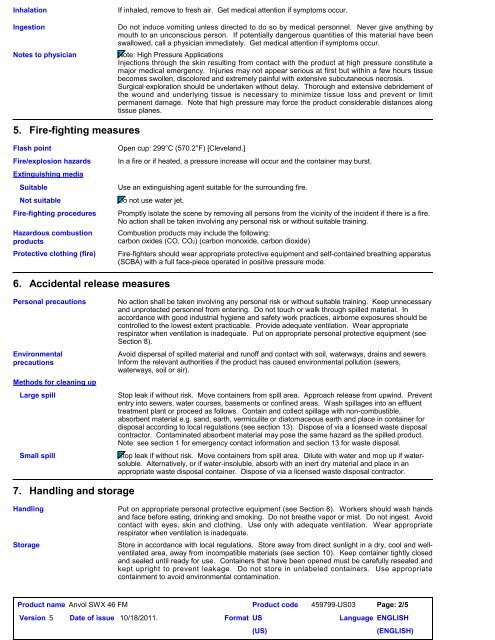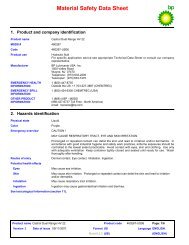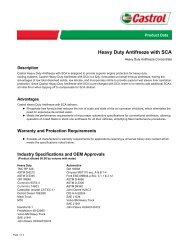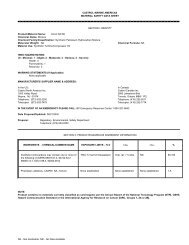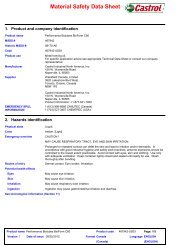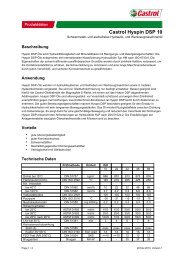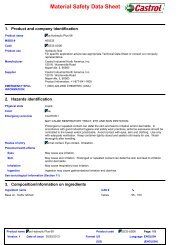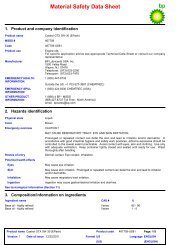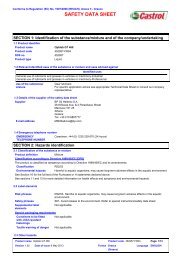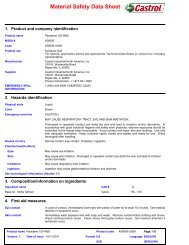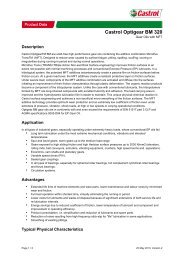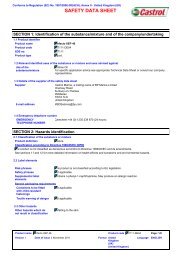(US)069654Anvol SWX 46 FM.pdf - Castrol
(US)069654Anvol SWX 46 FM.pdf - Castrol
(US)069654Anvol SWX 46 FM.pdf - Castrol
You also want an ePaper? Increase the reach of your titles
YUMPU automatically turns print PDFs into web optimized ePapers that Google loves.
Inhalation<br />
Ingestion<br />
Notes to physician<br />
If inhaled, remove to fresh air. Get medical attention if symptoms occur.<br />
Do not induce vomiting unless directed to do so by medical personnel. Never give anything by<br />
mouth to an unconscious person. If potentially dangerous quantities of this material have been<br />
swallowed, call a physician immediately. Get medical attention if symptoms occur.<br />
Note: High Pressure Applications<br />
Injections through the skin resulting from contact with the product at high pressure constitute a<br />
major medical emergency. Injuries may not appear serious at first but within a few hours tissue<br />
becomes swollen, discolored and extremely painful with extensive subcutaneous necrosis.<br />
Surgical exploration should be undertaken without delay. Thorough and extensive debridement of<br />
the wound and underlying tissue is necessary to minimize tissue loss and prevent or limit<br />
permanent damage. Note that high pressure may force the product considerable distances along<br />
tissue planes.<br />
5. Fire-fighting measures<br />
Flash point<br />
Fire/explosion hazards<br />
Extinguishing media<br />
Suitable<br />
Not suitable<br />
Fire-fighting procedures<br />
Hazardous combustion<br />
products<br />
Protective clothing (fire)<br />
Open cup: 299°C (570.2°F) [Cleveland.]<br />
In a fire or if heated, a pressure increase will occur and the container may burst.<br />
Use an extinguishing agent suitable for the surrounding fire.<br />
Do not use water jet.<br />
Promptly isolate the scene by removing all persons from the vicinity of the incident if there is a fire.<br />
No action shall be taken involving any personal risk or without suitable training.<br />
Combustion products may include the following:<br />
carbon oxides (CO, CO2) (carbon monoxide, carbon dioxide)<br />
Fire-fighters should wear appropriate protective equipment and self-contained breathing apparatus<br />
(SCBA) with a full face-piece operated in positive pressure mode.<br />
6. Accidental release measures<br />
Personal precautions<br />
Environmental<br />
precautions<br />
Methods for cleaning up<br />
Large spill<br />
Small spill<br />
No action shall be taken involving any personal risk or without suitable training. Keep unnecessary<br />
and unprotected personnel from entering. Do not touch or walk through spilled material. In<br />
accordance with good industrial hygiene and safety work practices, airborne exposures should be<br />
controlled to the lowest extent practicable. Provide adequate ventilation. Wear appropriate<br />
respirator when ventilation is inadequate. Put on appropriate personal protective equipment (see<br />
Section 8).<br />
Avoid dispersal of spilled material and runoff and contact with soil, waterways, drains and sewers.<br />
Inform the relevant authorities if the product has caused environmental pollution (sewers,<br />
waterways, soil or air).<br />
Stop leak if without risk. Move containers from spill area. Approach release from upwind. Prevent<br />
entry into sewers, water courses, basements or confined areas. Wash spillages into an effluent<br />
treatment plant or proceed as follows. Contain and collect spillage with non-combustible,<br />
absorbent material e.g. sand, earth, vermiculite or diatomaceous earth and place in container for<br />
disposal according to local regulations (see section 13). Dispose of via a licensed waste disposal<br />
contractor. Contaminated absorbent material may pose the same hazard as the spilled product.<br />
Note: see section 1 for emergency contact information and section 13 for waste disposal.<br />
Stop leak if without risk. Move containers from spill area. Dilute with water and mop up if watersoluble.<br />
Alternatively, or if water-insoluble, absorb with an inert dry material and place in an<br />
appropriate waste disposal container. Dispose of via a licensed waste disposal contractor.<br />
7. Handling and storage<br />
Handling<br />
Storage<br />
Put on appropriate personal protective equipment (see Section 8). Workers should wash hands<br />
and face before eating, drinking and smoking. Do not breathe vapor or mist. Do not ingest. Avoid<br />
contact with eyes, skin and clothing. Use only with adequate ventilation. Wear appropriate<br />
respirator when ventilation is inadequate.<br />
Store in accordance with local regulations. Store away from direct sunlight in a dry, cool and wellventilated<br />
area, away from incompatible materials (see section 10). Keep container tightly closed<br />
and sealed until ready for use. Containers that have been opened must be carefully resealed and<br />
kept upright to prevent leakage. Do not store in unlabeled containers. Use appropriate<br />
containment to avoid environmental contamination.<br />
Product name Anvol <strong>SWX</strong> <strong>46</strong> <strong>FM</strong><br />
Product code 459799-<strong>US</strong>03<br />
Version 5 Date of issue 10/18/2011.<br />
Format <strong>US</strong><br />
Language<br />
(<strong>US</strong>)<br />
Page: 2/5<br />
ENGLISH<br />
(ENGLISH)


